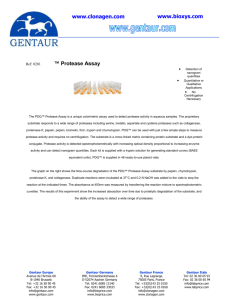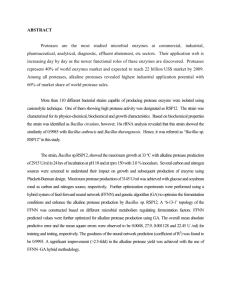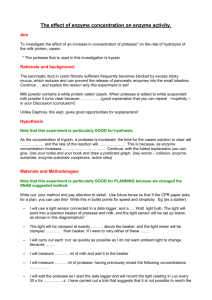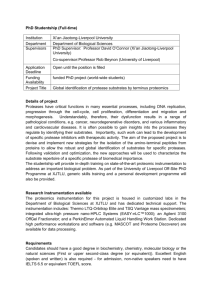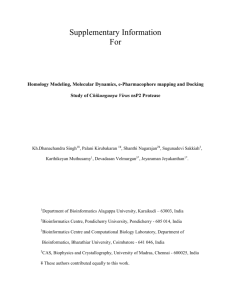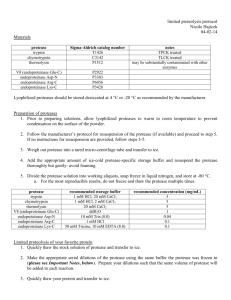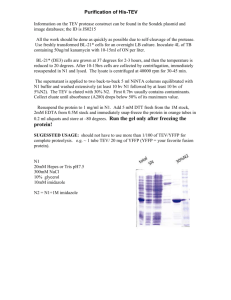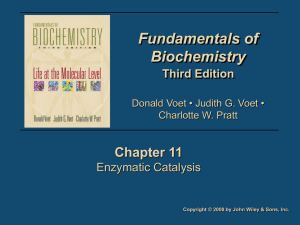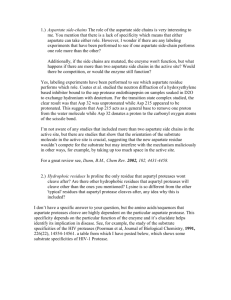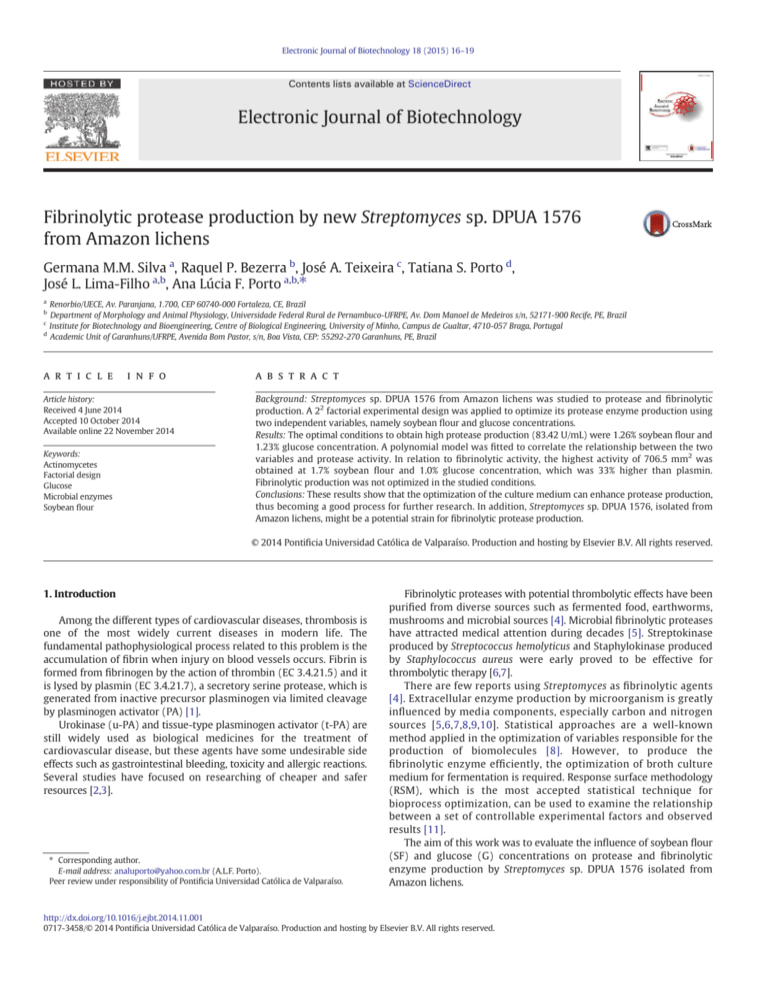
Electronic Journal of Biotechnology 18 (2015) 16–19
Contents lists available at ScienceDirect
Electronic Journal of Biotechnology
Fibrinolytic protease production by new Streptomyces sp. DPUA 1576
from Amazon lichens
Germana M.M. Silva a, Raquel P. Bezerra b, José A. Teixeira c, Tatiana S. Porto d,
José L. Lima-Filho a,b, Ana Lúcia F. Porto a,b,⁎
a
Renorbio/UECE, Av. Paranjana, 1.700, CEP 60740-000 Fortaleza, CE, Brazil
Department of Morphology and Animal Physiology, Universidade Federal Rural de Pernambuco-UFRPE, Av. Dom Manoel de Medeiros s/n, 52171-900 Recife, PE, Brazil
Institute for Biotechnology and Bioengineering, Centre of Biological Engineering, University of Minho, Campus de Gualtar, 4710-057 Braga, Portugal
d
Academic Unit of Garanhuns/UFRPE, Avenida Bom Pastor, s/n, Boa Vista, CEP: 55292-270 Garanhuns, PE, Brazil
b
c
a r t i c l e
i n f o
Article history:
Received 4 June 2014
Accepted 10 October 2014
Available online 22 November 2014
Keywords:
Actinomycetes
Factorial design
Glucose
Microbial enzymes
Soybean flour
a b s t r a c t
Background: Streptomyces sp. DPUA 1576 from Amazon lichens was studied to protease and fibrinolytic
production. A 22 factorial experimental design was applied to optimize its protease enzyme production using
two independent variables, namely soybean flour and glucose concentrations.
Results: The optimal conditions to obtain high protease production (83.42 U/mL) were 1.26% soybean flour and
1.23% glucose concentration. A polynomial model was fitted to correlate the relationship between the two
variables and protease activity. In relation to fibrinolytic activity, the highest activity of 706.5 mm2 was
obtained at 1.7% soybean flour and 1.0% glucose concentration, which was 33% higher than plasmin.
Fibrinolytic production was not optimized in the studied conditions.
Conclusions: These results show that the optimization of the culture medium can enhance protease production,
thus becoming a good process for further research. In addition, Streptomyces sp. DPUA 1576, isolated from
Amazon lichens, might be a potential strain for fibrinolytic protease production.
© 2014 Pontificia Universidad Católica de Valparaíso. Production and hosting by Elsevier B.V. All rights reserved.
1. Introduction
Among the different types of cardiovascular diseases, thrombosis is
one of the most widely current diseases in modern life. The
fundamental pathophysiological process related to this problem is the
accumulation of fibrin when injury on blood vessels occurs. Fibrin is
formed from fibrinogen by the action of thrombin (EC 3.4.21.5) and it
is lysed by plasmin (EC 3.4.21.7), a secretory serine protease, which is
generated from inactive precursor plasminogen via limited cleavage
by plasminogen activator (PA) [1].
Urokinase (u-PA) and tissue-type plasminogen activator (t-PA) are
still widely used as biological medicines for the treatment of
cardiovascular disease, but these agents have some undesirable side
effects such as gastrointestinal bleeding, toxicity and allergic reactions.
Several studies have focused on researching of cheaper and safer
resources [2,3].
⁎ Corresponding author.
E-mail address: analuporto@yahoo.com.br (A.L.F. Porto).
Peer review under responsibility of Pontificia Universidad Católica de Valparaíso.
Fibrinolytic proteases with potential thrombolytic effects have been
purified from diverse sources such as fermented food, earthworms,
mushrooms and microbial sources [4]. Microbial fibrinolytic proteases
have attracted medical attention during decades [5]. Streptokinase
produced by Streptococcus hemolyticus and Staphylokinase produced
by Staphylococcus aureus were early proved to be effective for
thrombolytic therapy [6,7].
There are few reports using Streptomyces as fibrinolytic agents
[4]. Extracellular enzyme production by microorganism is greatly
influenced by media components, especially carbon and nitrogen
sources [5,6,7,8,9,10]. Statistical approaches are a well-known
method applied in the optimization of variables responsible for the
production of biomolecules [8]. However, to produce the
fibrinolytic enzyme efficiently, the optimization of broth culture
medium for fermentation is required. Response surface methodology
(RSM), which is the most accepted statistical technique for
bioprocess optimization, can be used to examine the relationship
between a set of controllable experimental factors and observed
results [11].
The aim of this work was to evaluate the influence of soybean flour
(SF) and glucose (G) concentrations on protease and fibrinolytic
enzyme production by Streptomyces sp. DPUA 1576 isolated from
Amazon lichens.
http://dx.doi.org/10.1016/j.ejbt.2014.11.001
0717-3458/© 2014 Pontificia Universidad Católica de Valparaíso. Production and hosting by Elsevier B.V. All rights reserved.
G.M.M. Silva et al. / Electronic Journal of Biotechnology 18 (2015) 16–19
2. Material and methods
2.1. Microorganism and culture maintenance
Streptomyces sp. DPUA 1576 isolated from lichens Amazon was
obtained from the Culture Collection of the Parasitology Department
of the Federal University of Amazonas (DPUA), Brazil. The strain was
maintained in ISP-2 culture medium at 25°C in Castellani method [12].
2.2. Culture medium, inoculum preparation and protease production
Inoculum preparation was done in ISP-2 agar plates containing a
culture of cells grown on ISP-2 agar plate [13] for 7 d at 30°C. After,
the inoculum was incubated in ISP-2 broth in orbital shaker 200 rpm
for 48 h at 28°C. Cell concentration of 106 cells/mL was inoculated in
250 mL Erlenmeyer flask containing 50 mL of culture medium
described by Porto et al. [14] with different SF and G concentrations
(Table 1). After 72 h of cultivation, cell-free extract was obtained by
centrifugation at 8000 × g, at 4°C for 10 min and submitted to
protease and fibrinolytic activity determinations.
17
fibrinolytic production. To this purpose, multivariable regression
analyses were done under the conditions preliminarily determined by
the experimental design (Table 1). Such a design was based on the
methodology called “star planning,” proposed by Barros Neto et al.
[17], which consists of two factors in five levels of independent
variables. The central point was three fold repeated so as to check the
reproducibility of results. The independent variables SF and G
concentration and their corresponding ranges were selected on the
basis of the results of Porto et al. [14].
For predicting the optimal point, a second order polynomial function
was fitted to correlate relationship between independent variables and
responses. For the two factors this equation is:
2
2
Y ¼ β0 þ β1 X 1 þ β2 X 2 þ β11 X 1 þ β22 X 2 þ β12 X 1 X 2
½Equation 1
where Y is the predicted response, β0 is the model constant; X1 and X2
are the independent variables; β1 and β2 are the linear coefficients;
β12 is the cross product coefficients and β11 and β22 are the quadratic
coefficients. The quality of fit of the polynomial model equation was
expressed by the coefficient of determination R2. All data were treated
with Statistica 8.0 software (StatSoft Inc., Tulsa, OK, USA).
2.3. Evaluation of protease activity
3. Results and discussion
Proteolytic activity was made according to Alencar et al. [15] using
azocasein as substrate (Sigma Chemical Co., St Louis, MO). One unit
(U) of enzymatic activity was defined as the amount of enzyme
capable to produce a 0.001 change in absorbance at 440 nm per minute.
2.4. Evaluation of fibrinolytic activity
The crude extract was submitted to fibrinolytic activity on agar plate
according to the method described by Astrup and Mullertz [16], with
minor modifications as follows. The fibrin agarose plate was made by
1% agarose, 0.1% human fibrinogen (Sigma Chemical Co., St Louis,
MO), and 8 U/mL of human thrombin (Sigma Chemical Co., St Louis,
MO). The clot was allowed to stand for 1 h at room temperature
(25 ± 2°C). Then, 20 μL of sample solution was spotted directly onto
the fibrin plate, and then incubated at 37°C for 18 h and the diameter
of the lytic halo was measured. In the fibrin plate method, a clear
transparent region is observed in which fibrin is hydrolyzed, and its
diameter is directly proportional to the potency of the fibrinolytic
activity. The lysed area is given in mm2.
2.5. Experimental design and statistical analysis
3.1. Protease production
A Plackett–Burman design was used to evaluate the maximum
protease production as a function of SF and G concentrations. Using a
P-value lesser than 0.05, the analysis indicates that SF, G and their
interaction were significant variables, as shown in the Pareto chart
(Fig. 1).
Pareto's chart is a graphical representation of Student's t-test. The
parameter SF linear showed higher effect than quadratic SF indicating
that the increase of the concentration from 0.293 to 1.707% led to an
increase in protease production of 45.00 to 80.28 U/mL. In earlier
reports soybean meals were found effective ingredients for the
protease production by Nocardia sp. [18]. Soybean flour is commonly
used as a protein source in industrial fermentations to enzyme and
antibiotic production. Their protein concentration ranged 51.2–53.2%
depending on changes in growing conditions, but the overall amino
acid composition was relatively constant. The synthesis and secretion
of protease are induced by peptides or other protein substrates, such
as soybean flour. Depending on the peptide nature and level, protease
synthesis and secretion may be induced or repressed [18]. Thus,
protease production can be employed across a wide range of SF.
Response surface method was utilized to determine the influence of
the two independent variables SF and G concentration on the two
responses variable selected for this study, namely protease and
(1)Soybean flour(L)
Table 1
Experimental design and results of the central composite design for protease and
fibrinolytic activity production by Streptomyces sp. DPUA 1576.
Run
1
2
3
4
5
6
7
8
9
10
11
Coded variable
Uncoded variable
Response
X1
X2
Soybean flour
(%)
Glucose
(%)
PA (U/mL)
measured
PA (U/mL)
predicted
FA
(mm2)
-1
1
-1
1
0
0
0
-1.414
1.414
0
0
-1
-1
1
1
0
0
0
0
0
-1.414
1.414
0.5
1.5
0.5
1.5
1
1
1
0.293
1.707
1
1
0.5
0.5
1.5
1.5
1
1
1
1
1
0.293
1.707
55.00
60.00
1.11
84.89
74.39
71.78
76.83
45.00
80.28
39.22
73.39
57.22
52.51
17.83
91.89
74.33
74.33
74.33
33.51
82.54
51.69
51.69
600.87
615.44
146.62
672.38
660.19
637.62
490.63
397.41
706.5
572.27
637.62
PA: protease activity (U/ml); FA: fibrinolytic activity (mm2).
19,41
1Lby2L
15,59
glucose(Q)
-10,65
Soybean flour(Q)
(2)glucose(L)
-7,671
2,704
p=0,05
Effect Estimate (Absolute Value)
Fig. 1. Pareto chart for protease production by Streptomyces sp. DPUA1576.
18
G.M.M. Silva et al. / Electronic Journal of Biotechnology 18 (2015) 16–19
Soybean medium may be considered a promising and inexpensive
alternative for protease production. For Brazil, the utilization of
soybean flour is especially important, as the country is the world's
largest soybean producer [18]. The linear effect of G was not
statistically significant (Table 2), but it remained in the model to
improve the regression coefficient. The quadratic effect of G was
negative and statistically significant indicating that the range of G
evaluated was adequate to optimization G on protease production.
Other authors are in agreement with these results. Mehta et al. [19]
and Patel et al. [20], working respectively with alkaliphilic
actinomycete was isolated from soil and Bacillus sp., noted that high
concentrations of glucose inhibited enzyme production, and a 0.5%
(w/v) concentration was optimal for protease production.
Interaction between SF and G had a positive effect for protease
production, indicating that the variable influences each other; this
may be caused by the SFB, although with high content of nitrogen
from protein, it has a carbon skeleton which may be used as carbon
source and which can interfere in glucose uptake by microorganisms.
In order to approach the optimum response region of the enzymes
production, significant independent variables (soybean concentration,
X1 and glucose concentration, X2) were further explored, each at five
levels. Statistical optimization of medium components is a critical
point for better protease production.
Regression coefficients of the fitted quadratic model [Equation 1]
obtained for protease activity as the function of SF and G are presented
in Table 1, and it was examined in terms of the appropriateness of fit.
To improve the regression fit for protease activity, the linear coefficient
of G was neglected in the adjustment of the mathematical model.
The first step for the determination of an empirical model, beyond
response surface methodology, is approximating the function (f), in
independent variable region. If the response can be modeled by a
linear function, then the approximate function is a model of first
order. If curvature exists in the system or in the optimum region, then
a polynomial of superior degree, as a second order model, must be
utilized to approach the response [21].
Statistical significance which was evaluated by ANOVA (Table 1)
indicated that the second-order model generated for maximum
protease activity (Y) was statistically significant and showed a
satisfactory determination coefficient of R2 = 0.81 (a value of
R2 N 0.75 indicates the aptness of the model) [22], which ensured a
satisfactory adjustment of the quadratic model to the experimental
data and independent variable.
The model shows all significant terms (P-value lesser than 0.05).
Thus, the difference between the experimental values and the values
predicted by the model could be elucidated only by experimental
error. The residues explained the lasting 9%. Thus, the mathematical
model that describes the production of protease can be represented by
[Equation 2]:
2
From the response surface presented in Fig. 3, an optimum region
comprising the 1.26% of SF and 1.23% of G can be observed, which
means the appropriate range for reaching the best results for protease
activity. Fig. 2 also shows that there are maximum values of protease
activity, indicating that this variable was optimized as a function of SF
and G concentrations.
The ANOVA was conducted for the second order response surface
model. The significance of each coefficient was determined by
P-values, which were listed in Table 2.
Results still show that the optimization promoted an increase of 12%
in protease values when compared to basal medium ISP-2. Indeed, it is a
clear advantage of using RSM to estimate optimal SF and G
concentrations for enzymatic activity, providing higher flexibility in
the development of different bioprocesses.
The optimization of protease production by Streptomyces sp. DPUA
1576 of 83 U/mL achieved was greater than the optimized enzyme
production achieved in other works which employed Bacillus sp. I-312
(28.630 U/mL) [23] and Streptomyces sp. 594 isolated from a Brazilian
cerrado soil (56 U/mL) [24], demonstrating that SF and G represent a
viable culture medium for protease production from Streptomyces sp.
DPUA 1576.
3.2. Fibrinolytic enzyme production
In order to search for the optimal combination of some components
of the fermentation process, to enhance the fibrinolytic production,
experiments were performed according to a 22 factorial design
(Table 1). Concerning the results, it can be observed that the lowest
fibrinolytic activity (1.11 mm2) was obtained by employing low levels
of SF and high levels of G. Considering these observations, SF and G
sharply influenced the fibrinolytic production.
Although the influence of the studied variables can be analyzed
separately, the main effects and the existence of interaction effects
among them could be better evaluated by employing the statistical
analysis. Fig. 3 shows the Pareto's chart that represents the estimated
effects of SF and G on fibrinolytic activity response. The measure of
each bar is proportional to the estimate effect. The vertical line is used
to evaluate which effects are statistically significant in a 90% of
confidence level. SF and interaction between SF and glucose presented
a positive significant effect on fibrinolytic activity (P b 0.10), which
2
Y ¼ 74:33 þ 17:33X 1 −8:152X 1 −11:32X 2 þ 19:69X 1 X 2 ½Equation 2
where Y is the predicted response of protease activity, and X1 and X2 are
the coded values of SF and G, respectively. This model was used to
construct response surface plots, which show the experimental and
predicted values of maximum protease activity as a response (Fig. 2).
Table 2
Statistical analysis of Plackett–Burman's design showing coefficient values and p-values
for each variable for protease activity.
Mean/intercept
X1
X11
X22
X1 X2
Adjusted R2 = 0.81; P b 0.05.
Coefficient regression
P-value
74.33
17.33
-8.152
-11.32
19.95
0.000385
0.002643
0.016573
0.008699
0.004086
Fig. 2. Response surface showing the effects of soybean flour and glucose on protease
production by Streptomyces sp. DPUA 1576.
G.M.M. Silva et al. / Electronic Journal of Biotechnology 18 (2015) 16–19
19
References
(1)Soybean(L)
3,209
1Lby2L
2,374
(2)Glucose(L)
-1,001
Soybean(Q)
Glucose(Q)
-0,872
-0,287
p=0,1
Effect Estimate (Absolute Value)
Fig. 3. Pareto chart for fibrinolytic enzyme production by Streptomyces sp. DPUA 1576.
means that the highest SF improves the fibrinolytic enzyme production
(Table 1).
The highest main effect observed to the specific activity response
was the variable SF that presented estimation of (3.21), followed by
interaction between SF and glucose concentration, (+ 4.53). All other
variables and their interactions had no significant effects on
fibrinolytic production. The highest fibrinolytic activity was around
670 mm2, values higher than those from 6 strains were isolated from
natto fermented foods (475 mm2) and similar to 6 strains isolated
from doufuru fermented foods (655 mm2) [25]. Soybean powder was
reported as the best nitrogen organic source for fibrinolytic protease
production from Streptomyces sp. NRC 411 [26]. Requirement for
specific nitrogen source differs from organism to organism or even
among the same species isolated from different sources [27].
There is no general defined medium for fibrinolytic enzyme
production by different microorganisms. Every microorganism has its
own peculiar nutritional requirements for enzyme production. In view
of the commercial utility of the enzyme, devising a cost-effective
media formulation becomes a primary concern.
4. Conclusions
Streptomyces sp. DPUA1576 is a suitable microorganism to protease
and fibrinolytic production. The maximum predicted protease
production (83.42 U/mL) could be achieved with the medium
consisting of soybean flour 1.26% and glucose 1.23% concentration. To
fibrinolytic production, the high activity of 706.50 mm2 was obtained
at 1.7% of soybean flour and 1.0% of glucose which was 33% higher
than plasmin positive control (176.62 mm2). Therefore, the
fibrinolytic protease production by Streptomyces sp. DPUA1576
emerges as a good alternative for further therapeutical application
using biotechnology process.
Financial support
The authors thank CAPES (National Council for the Improvement of
Higher Education) for the scholarship and CNPq/RENORBIO (National
Counsel of Technological and Scientific Development, N.55146/
2010-3) and FACEPE (Fundação de Amparo à Ciência e Tecnologia do
Estado de Pernambuco, 0158-2.12/11) for the financial support.
Conflict of interest
The authors declared no potential conflict of interest with respect to
the research, authorship, and/or publication of this article.
[1] Nagai N, Matsuo O. Roles of fibrinolytic system components in the nervous system.
Pathophysiology 2010;17:141–7. http://dx.doi.org/10.1016/j.pathophys.2009.03.006.
[2] Hua YJB, Mine Y, Mu W. Purification and characterization of a novel fibrinolytic enzyme from Bacillus sp. nov. SK006 isolated from an Asian traditional fermented shrimp
paste. J Agric Food Chem 2008;56:1451–7. http://dx.doi.org/10.1021/jf0713410.
[3] Thelwell C. Fibrinolysis standards: A review of the current status. Biologicals 2010;
38:437–48. http://dx.doi.org/10.1016/j. biologicals .2010.02.006.
[4] Simkhada JR, Mander P, Cho SS, Yoo JC. A novel fibrinolytic protease from Streptomyces sp.
CS684. Process Biochem 2010;45:88–93. http://dx.doi.org/10.1016/j.procbio.2009.08.010.
[5] Peng Y, Xiaojuan Y, Yizheng Z. Microbial fibrinolytic enzymes: An overview of
source, production, properties, and thrombolytic activity in vivo. Appl Microbiol
Biotechnol 2005;69:126–32. http://dx.doi.org/10.1007/s00253-005-0159-7.
[6] Kim HK, Kim GT, Kim DK, Choi WA, Park SH, Jeong YK, et al. Purification
and characterization of a novel fibrinolytic enzyme from Bacillus sp.
KA38 originated from fermented fish. J Ferment Bioeng 1997;84:307–12.
http://dx.doi.org/10.1016/S0922-338X(97)89249-5.
[7] Choi HS, Shin HH. Purification and partial characterization of a fibrinolytic protease in
Pleurotus ostreatus. Mycologia 1998;90:674–9. http://dx.doi.org/10.2307/3761226.
[8] Ya-Hong X, Jian-Zhong L, Hai-Yan S, Liang-Nian J. Enhanced production of extracellular ribonuclease from Aspergillus niger by optimization of culture conditions using response surface methodology. Biochem Eng J 2004;21:27–32.
http://dx.doi.org/10.1016/j.bej.2004.04.010.
[9] Karan R, Singh SP, Kapoor S, Khare SK. A novel organic solvent tolerant protease
from a newly isolated Geomicrobium sp. EMB2 (MTCC 10310): Production optimization by response surface methodology. New Biotechnol 2011;28:136–45.
http://dx.doi.org/10.1016/j.nbt.2010.10.007.
[10] Liu J, Xing J, Chang T, Ma Z, Liu H. Optimization of nutritional conditions for nattokinase
production by Bacillus natto NLSSE using statistical experimental methods. Process
Biochem 2005;40:2757–62. http://dx.doi.org/10.1016/j.procbio.2004.12.025.
[11] Rai SK, Mukherjee AK. Statistical optimization of production, purification and
industrial application of a laundry detergent and organic solvent-stable subtilisin-like
serine protease (Alzwiprase) from Bacillus subtilis DM-04. Biochem Eng J 2010;48:
173–80. http://dx.doi.org/10.1016/j.bej.2009.09.007.
[12] Castellani A. Maintenance and cultivation of common pathogenic fungi of man in
sterile distilled water. Further researches. J Trop Med Hyg 1967;70:181–4.
[13] Pridham TG, Anderson P, Foley C, Lindenfelser LA, Hesseltine CW, Benedict RG. A
selection of media for maintence and taxonomic study of Streptomyces. Antibiotics
manual. New York: Medical Encyclopedia Inc.; 1957 947–53.
[14] Porto ALF, Campos-Takaki GM, Lima-Filho JL. Effects of culture conditions on protease
production by Streptomyces clavuligerus growing on soy bean flour medium. Appl
Biochem Biotechnol 2006;60:115–22. http://dx.doi.org/10.1007/BF02788066.
[15] Alencar RB, Biondi MM, Paiva PMG, Vieira VLA, Carvalho Jr LB, Bezerra RS. Alkaline
proteases from digestive tract of four tropical fishes. Braz J Food Technol 2003;6:
279–84.
[16] Astrup T, Mullertz S. The fibrin plate method for estimating of fibrinolytic activity. Arch
Biochem Biophys 1952;40:346–51. http://dx.doi.org/10.1016/0003-9861(52)90121-5.
[17] Barros Neto B, Scarminio IS, Bruns RE. Planejamento e otimização de experimentos.
2nd ed. Campinas-SP, Brazil: Editora da UNICAMP; 1996.
[18] Cavalcanti MTH, Martinez CR, Furtado VC, Neto BB, Teixeira MF, Lima Filho JL, et al. Milkclotting protease production by Nocardiopsis sp. in an inexpensive medium. World J
Microbiol Biotechnol 2005;21:151–4. http://dx.doi.org/10.1007/s11274-004-3470-z.
[19] Mehta VJ, Thumar JT, Singh SP. Production of alkaline protease from an
alkaliphilic actinomycete. Bioresour Technol 2006;97:1650–4.
http://dx.doi.org/10.1016/j.biortech.2005.07.023.
[20] Patel R, Dodia M, Singh SP. Extracellular alkaline protease from a newly isolated
haloalkaliphilic Bacillus sp.: Production and optimization. Process Biochem 2005;
40:3569–75. http://dx.doi.org/10.1016/j.procbio.2005.03.049.
[21] Gurpilhares DB, Pessoa Jr A, Roberto IC. Glucose-6-phosphate dehydrogenase and xylitol production by Candida guilliermondii FTI 20037 using statistical experimental design.
Process Biochem 2006;41:631–7. http://dx.doi.org/10.1016/j.procbio.2005.08.008.
[22] Puri S, Beg QK, Gupta R. Optimization of alkaline protease production from
Bacillus sp. by response surface methodology. Curr Microb 2002;44:286–90.
http://dx.doi.org/10.1007/s00284-001-0006-8.
[23] Joo HS, Chang CS. Production of protease from a new alkalophilic Bacillus sp. I-312
grown on soybean meal: Optimization and some properties. Process Biochem
2005;40:1263–70. http://dx.doi.org/10.1016/j.procbio.2004.05.010.
[24] Azeredo LAI, Castilho LR, Leite SGF, Coelho RRR, Freire DMG. Protease production by
Streptomyces sp. isolated from Brazilian cerrado soil. Appl Biochem Biotechnol 2003;
108:749–55. http://dx.doi.org/10.1385/ABAB:108:1-3:749.
[25] Chen B, Huo J, He Z, He Q, Hao Y, Che Z. Isolation and identification of an effective
fibrinolytic strain Bacillus subtilis FR-33 from the Chinese doufuru and primary
analysis of its fibrinolytic enzyme. Afr J Agric Res 2013;7:2001–9.
[26] Abedel-Naby MA, El-Diwany AI, Shaker HM, Ismail AMS. Production and properties
of fibrinolytic enzyme from Streptomyces sp. NRC 411. World J Microbiol Biotechnol
1992;8:267–9. http://dx.doi.org/10.1007/BF01201876.
[27] Bajaj BK, Sharma P. An alkali-thermotolerant extracellular protease from a
newly isolated Streptomyces sp. DP2. New Biotechnol 2011;28:725–32.
http://dx.doi.org/10.1016/j.nbt.2011.01.001.

